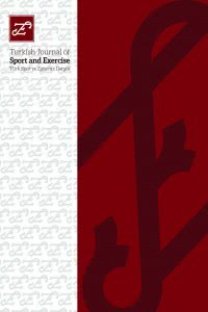Sınıf Öğretmenliği öğrencilerinin Beden Eğitimi ve Oyun Öğretimi dersine ilişkin görüşlerin incelenmesi
Investigating the opinion of students from the Department of Primary Education about the Course of Physical Education and Game Teaching
___
- 1. Anderson A, Moore O. Autofelic Folk Models. Sociological Quartely, 1960, 1, s.203-216.
- 2. Aracı H. Öğretmenler ve Öğrenciler İçin Okullarda Beden Eğitimi.Yardımcı Ofset, 1998, s. 345-346.
- 3. Bruner J, et al. Play: Its role in Deveolopment and Evolution, New York: Penguin Boks, 1976.
- 4. Caplan F, Caplan T. The power of play. Garden City , N.Y, Anchor Press,1973.
- 5. Çoban B, Ünveren A. Sınıf Öğretmenleri, Beden Eğitimi Öğretmenleri, Stajyer Öğrenciler ve Öğretim Elemanları İçin Beden Eğitimi ve Oyun Öğretimi. Nobel Yayın, 2007, Ankara, s.1.
- 6. Denzin N. Play, games and interaction: The contexts of childhood socialization. The Sociological Quartely, 16, 1975, (Autumn), s.458-478.
- 7. Ellis MJ. Why People Play. Englewoood Cliffs NJ, Prentice-Hall, 1973.
- 8. Erikson E. Toys and reason. Newyork: Norton 1977.
- 9. Fagot BI. The influence of sex of childon parental reaction. Development Psychology, 1978, 10, s.554-558.
- 10. Greendorfer SL. Shaping the female athlete. The role of family. In M. Boutilier & L. San Giovanni, The sporting woman, s.135-156.Champaign, IL: Human Kinetics,1983.
- 11. Greendorfer SL, Lewko JH. Children’s socialization into sport: a conceptual and empirical analysis. Paper. World Congrees of Sociology. Uppsala, Sweden, 1978 b.
- 12. Herrison R, Sutton-Smith B. Child’s Play.1971, New York: John Wiley.
- 13. Huizinga J. Home Ludens: Versuch einer Bestimmung des Spielelementes der kultur, Pantheon, Amsterdam, 1939.
- 14. İnal AN. Beden Eğitimi ve Spor Bilimi, Nobel Basımevi, 2003.
- 15. Langlois JH, Downs AC. Mothers, fathers and sisters as socialization agent of sex-typed play behaviors in young children. Child Development. 1980; 51: 1237-1247.
- 16. Lever J. Sex differences in the games children play. Social Problems,1976: 23: 478-487.
- 17. Lewko JH, Greendorfer SL. Family influence and sex differences in children’s socialization into sport:A review. In R.A. Magill, M. J. Ash, F. L. Smoll (Ed.), Children in sport. Champaign, IL: Human Kinetics.1980, 2nd ed., s.279-293.
- 18. Lewis M. Culture and gender roles : There is no unisex in the nursery. Psychology Today 1972; 5: 54-57.
- 19. Lieberman JN. Playfulness, New York: Academic Pres, 1977.
- 20. Lüschen G. The interpendence of sport and culture. International Review of Sport Socilogy, 1967; 2: 127-141.
- 21. McPherson BD. Handbook of Social Science of Sport; Socialization into and through sport involvement. In G. Lueschen & G. Sage(Ed), Handbook of social science of sport. Champaign, IL: Stipes, 1981, s.246- 273.
- 22. Mead GH. Mind, self and society. Chicago: University of Chicago Press, 1934.
- 23. Metheny E. Connotations of movement in sport and dance. Dubuque, I A:William C. Brown, 1965.
- 24. Millar S. The Psychology of Play, New York: Penguin Boks, 1968.
- 25. Ökmen AŞ. Okullarda Beden Eğitimi ve Sporun Öğrencilerin Toplumsallaşmasındaki Rolü. Doktora tezi, Atatürk Üniversitesi, Erzurum, 2003.
- 26. Piaget J. The moral judgement of child, New York: Free Press, 1965.
- 27. Piaget J. Play, Dreams and Imitation in Childhood, New York: W.W. Norton, 1962.
- 28. Power TG, Parke RD. Play as a context for early learning: Lab and home analyses. In I.E.
- 29. Siegel L, Asosa M (Ed.). The family as a learning environment, New York: Plenium. 1982.
- 30. Roberts J, Sutton-Smith B. Child traning and game involvement. Ethnology, 1962, 1,1: 166-185.
- 31. Tamer K. Beden Eğitimi ve Oyun Öğretimi, Anadolu Üniversitesi, Açıköğretim Fakültesi Ders Kitabı, Meteksan Ltd. Şti., Ankara, 1987.
- 32. Tasch RG. The role of the father in the family. Journal of Experimental Education. 1952, 20: 319-361.
- 33. Tauber MA. Parental socialization techniques and sex differences in children’s play. Child Development, 1979; 50: 225-234.
- 34. Ulrich C. The Social Matrix of Physical Education. Englewood Cliffs, N.J., Prentice-Hall, Inc., 1968.
- ISSN: 1300-9915
- Yayın Aralığı: Yıllık
- Başlangıç: 2018
- Yayıncı: -
AYŞEGÜL ŞÜKRAN ÖZ, HÜSEYİN KIRIMOĞLU, Ali TEMİZ
Drop sıçramada optimal platform yüksekliğinin belirlenmesi
TÜLİN ATAN, M. Yalçın TAŞMEKTEPLİGİL, Seydi A. AĞAOĞLU, MENDERES KABADAYI, ÖZGÜR BOSTANCI, OSMAN İMAMOĞLU
Basketbolcuların oyun pozisyonlarına göre reaksiyon zamanlarının karşılaştırılması
MUSA ÇON, MEHMET YAZICI, M. Yalçın TAŞMEKTEPLİGİL, Kazım BIYIK
Hakan Salim ÇAĞLAYAN, Mehmet Çağrı ÇETİN, YUNUS YILDIRIM, Özer YILDIZ
HAKKI ULUCAN, A. Emre EROL, FATİH BEKTAŞ, İdris YILMAZ
Performance analysis and its didactic applicability in the motor-sports and educational field
Stefania CARROZZA, Giuseppe BALDASSARRE, Rodolfo VASTOLA, Filipo PALOMA GOMEZ
Participation in homework exercise and its effects on physical fitness in Turkish adolescents
NURİ KARABULUT, HÜSEYİN ÇAMLIYER
